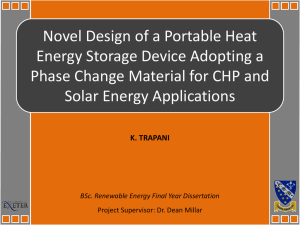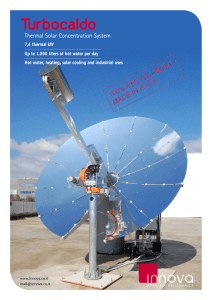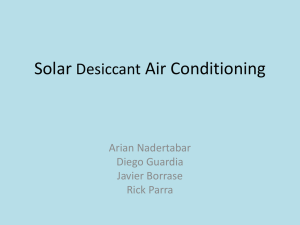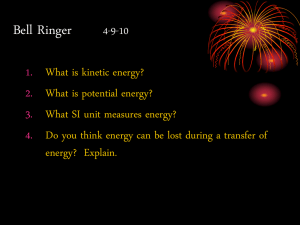Energy Storage
advertisement
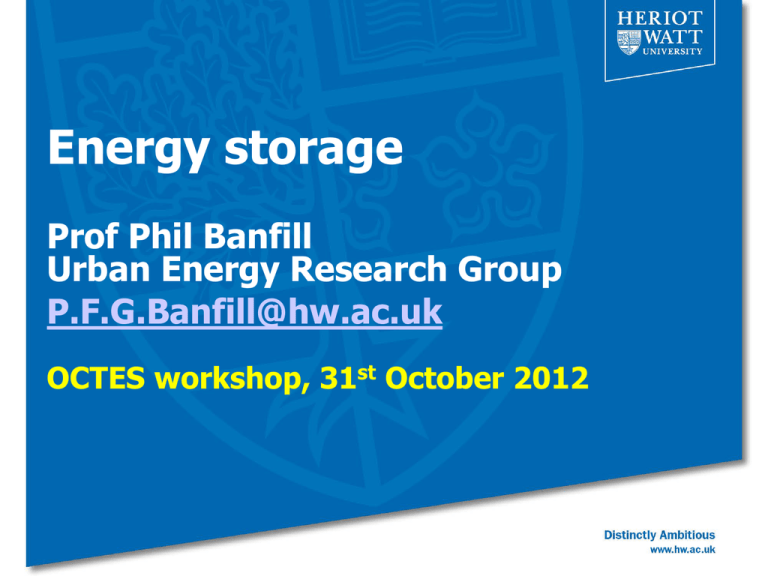
Energy storage Prof Phil Banfill Urban Energy Research Group P.F.G.Banfill@hw.ac.uk OCTES workshop, 31st October 2012 Urban Energy Research Group Skills/Experience in retrofit and new build: • Building simulation and modelling, including district and regional scale • Climate projections • System and equipment integration • Energy monitoring and analysis / metering • Retrofit measures - domestic and non-domestic • “Soft Landings” initiative - users and commissioning • Life Cycle Assessment - environmental impacts • Whole Life Costs • Thermal comfort • “Solar cities” initiative £3.5m research project funding since 2004 Energy storage Aims to reduce energy consumption by smoothing out the fluctuations – whether electrical or thermal energy temp Heat surplus Desired temp Heat deficit time Ambient temp Energy storage Aims to reduce energy consumption by smoothing out the fluctuations – whether electrical or thermal energy temp Heat surplus Store this heat Desired temp Heat deficit time Ambient temp Exposed thermal mass smoothes fluctuations simple model: mass = storage solar gains internal gains: lights, appliances, cooking, hot water, occupants ventilation losses T inside temperature fabric losses Thanks to Paul Tuohy thermal storage outside temperature simple model: mass = storage low thermal mass: surface temperature is responsive to solar gains and heating T high thermal mass: surface temp less responsive to solar gains and heating simple model solar gains internal gains: lights, appliances, cooking, hot water, occupants ventilation losses T Comfort? inside temperature fabric losses thermal storage outside temperature Comfort depends on Tsurface and Tair Standard House Passive House T from EIV simple model: mass = storage low thermal mass: surface temperature is responsive to solar gains and heating 2 days in October high thermal mass: surface temperature less responsive to solar gains and heating T simple model: mass = storage low thermal mass: surface temperature is responsive to solar gains and heating Faster response to heating system? T high thermal mass: surface temp less responsive to solar gains and heating Better storage of solar and internal gains? Types of thermal storage Sensible heat – i.e. elevated temperature, thermal mass Latent heat – by change of phase Chemical heat – by exo- or endo-thermic chemical reactions The important parameter is the energy density = heat change x density Energy density - materials Sensible heat Stone, concrete etc 1.5-3.5 MJ/m3°C Water 4.15 MJ/m3°C Latent heat Eutectic mixtures, salt hydrates, organics (incl. waxes) up to 100 MJ/m3 Chemical heat Absorbents etc 100-200 MJ/m3°C Phase change materials Phase change materials as room linings can make a difference Wax impregnated gypsum wallboard Potential applications / systems Room linings – products already available but issues of phase change temperature. Storage tanks = “heat batteries” but issues of heat exchange, size, location. Conclusions Low thermal mass buildings respond faster to heating and occupancy High thermal mass responds slower but stores the internal gains Heat can be stored in various materials with a range of efficiencies – significant amounts of material are needed for the effects to be worthwhile. Issues of cost. Thank you for listening P.F.G.Banfill@hw.ac.uk @HWUrbanEnergy





